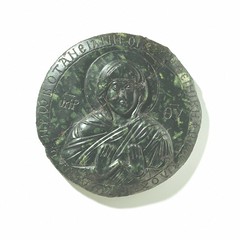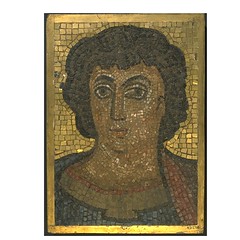By Stuart Frost
 What does the word Byzantine mean to you? If the answer is not very much I suspect that you’re not alone. The word was one of the period terms we tested with focus groups. These took place in the autumn of 2002 when we conducted research to feed into the planning for the Medieval and Renaissance Galleries. Byzantium was unfamiliar to almost all of the participants in the focus groups. This isn’t surprising as Byzantine history isn’t a subject that is widely studied in Britain. It isn’t, for example, included in the National Curriculum for England and Wales.
What does the word Byzantine mean to you? If the answer is not very much I suspect that you’re not alone. The word was one of the period terms we tested with focus groups. These took place in the autumn of 2002 when we conducted research to feed into the planning for the Medieval and Renaissance Galleries. Byzantium was unfamiliar to almost all of the participants in the focus groups. This isn’t surprising as Byzantine history isn’t a subject that is widely studied in Britain. It isn’t, for example, included in the National Curriculum for England and Wales.
In 330 the Roman Emperor Constantine the Great founded the city of Constantinople on the site of Byzantium. The new city was to replace Rome as the capital of the Roman world and to become the centre of an empire that endured until 1453. The modern label for this empire is Byzantine although contemporaries described it as the Empire of the Romans. The Byzantine empire was finally brought to an end by the Ottoman Turks in 1453. Constantinople is now known better known as Istanbul. There are many reasons that help explain why an empire which endured for so long is not better known by the public.
The Byzantium 330-1453 exhibition at the Royal Academy provides a wonderful opportunity for those who are intrigued about Byzantine art to find out more. There are some stunningly beautiful objects in the displays. I’ve been looking forward to this exhibition ever since I heard about it for various reasons. I was particularly interested to see how the exhibition team would cope with the challenge of covering a chronological span as vast as 330-1453 in a comparatively small number of rooms. The Medieval and Renaissance Galleries have an equally challenging scope, covering all of Europe from 300-1600, so it is always illuminating to see the decisions that other institutions make when faced with a similar situation.
Whilst the V&A’s own medieval and Renaissance collections don’t provide a comprehensive overview of Byzantine art history they do include a small but significant number of key objects. In fact a number of objects that will appear in the V&A’s new Medieval and Renaissance Galleries are on display currently at the Royal Academy.
It is endlessly fascinating to see how other institutions display and interpret objects from the V&A’s collections. Seeing a familiar object alongside artefacts from different collections often generates new thoughts and ideas. I’ve illustrated this blog entry with pictures of a number of those V&A objects that can be seen in the Byzantium show. As always click on the image if you’d like to know more about the object.
Click here to find out more about the Byzantium 330-1453 exhibition at the Royal Academy, London.